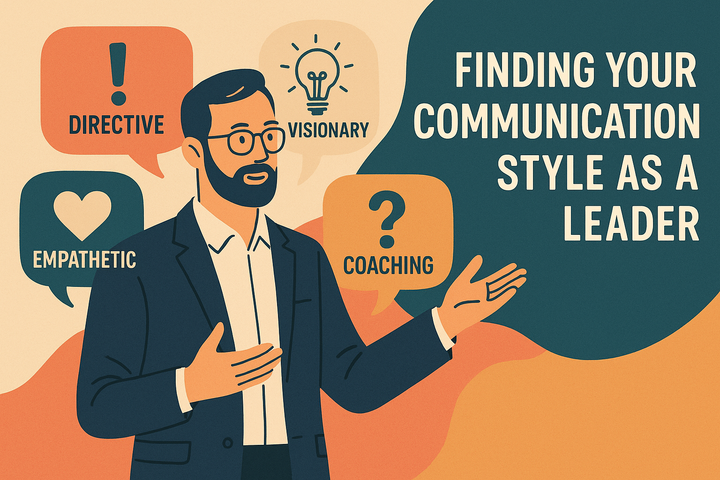From Communicator to Catalyst: The Leadership Leap
Explore how effective communication and empathy can transform leadership, driving engagement and success within teams and organisations.

Only 34% of business change initiatives succeed, and just 13% of employees feel their leaders communicate effectively. The gap between basic communication and impactful leadership is significant, but bridging it can transform outcomes.
Key Takeaways:
- Effective communication increases success: Consistent communication makes change efforts 12.4x more likely to succeed.
- Empathy matters: 88% of employees say mutual empathy boosts efficiency, yet only 25% feel their leaders meet expectations.
- Trust and engagement drive results: Poor communication leads to a 74-point trust gap, while strong communication fosters 93% positivity towards change.
5 Essential Skills for Leadership Communication:
- Simplify complexity: Break down big ideas into clear, actionable steps.
- Listen actively: Understand and act on feedback to build trust.
- Adapt to your audience: Tailor your message, tone, and delivery.
- Use impactful stories: Personal stories make messages relatable and memorable.
- Be direct and honest: Clarity and integrity drive trust and engagement.
Quick Comparison: Basic vs Transformative Communication
| Basic Communication | Transformative Communication |
|---|---|
| Shares information | Builds understanding |
| Focuses on "what" | Explains the "why" |
| One-way broadcast | Encourages dialogue |
| Generic messages | Tailored to the audience |
| Assumes understanding | Actively checks for it |
To lead effectively, focus on meaningful communication that inspires action, fosters trust, and aligns teams with organisational goals.
Transformational Communication | Doc Barham
Moving Beyond Basic Communication
The gap between basic communication and effective leadership communication is significant. While 88% of workers believe mutual empathy between leaders and employees improves efficiency, only 25% feel their leader's communication meets expectations. This disconnect highlights the need for a more thoughtful approach.
From Sharing to Shaping
Leadership communication isn't just about sending out messages - it's about inspiring action. The best leaders go beyond sharing information. They build a clear narrative and use relatable stories to turn abstract ideas into meaningful actions. Here's how basic communication compares to a more impactful approach:
| Basic Communication | Transformative Communication |
|---|---|
| Shares information | Builds understanding |
| Focuses on what | Explains the why |
| One-way broadcast | Encourages dialogue |
| Generic messages | Tailored to the audience |
| Assumes understanding | Actively checks for it |
This approach helps connect strategic goals to practical, measurable results.
Impact Beyond Words
When leaders move from simply delivering information to fostering true engagement, the benefits ripple across their organisations. Research shows that genuine empathy between leaders and employees can lead to:
- 87% increase in creativity
- 87% boost in job satisfaction
- 85% rise in innovation
- 83% growth in revenue
In critical situations, leaders need to ensure not just understanding but also commitment.
Interestingly, leaders are 10 times more likely to be criticised for under-communicating than over-communicating. But the solution isn’t simply to talk more - it’s about communicating with purpose. This includes avoiding jargon, offering clear reasoning behind decisions, and creating opportunities for open discussions about challenges.
With 76% of employees feeling burned out or disengaged in their roles, leaders must go beyond basic information sharing. To drive success, they need to focus on meaningful communication that fosters connection and engagement, benefiting both individuals and the organisation as a whole.
5 Must-Have Communication Skills
Moving from being a basic communicator to a true leader requires mastering five key skills. These skills help you go beyond just sharing information - they enable you to inspire action and drive meaningful change.
Making Complex Things Simple
Great leaders take complicated ideas and break them down into clear, actionable steps. It’s not about oversimplifying - it’s about creating clarity that leads to results.
Here’s a framework to simplify complexity:
| Communication Level | What It Means | Impact |
|---|---|---|
| Strategic | Connect daily tasks to larger goals | Teams see how their work fits into the big picture |
| Operational | Simplify complex projects | Clearer execution paths |
| Personal | Relate changes to individual roles | Boosted engagement and commitment |
But simplifying isn’t enough - you also need to listen carefully to truly understand and act on insights.
Listening with Purpose
Active listening isn’t just about hearing words; it’s about understanding and acting on feedback. Leaders who listen carefully gain new perspectives and build trust within their teams.
Speaking to Different Audiences
After listening and learning, it’s crucial to adjust how you communicate based on who you’re speaking to. The message stays the same, but how you deliver it should align with the audience’s needs.
Here’s how to adapt your communication:
- Know your audience: Understand what matters to them.
- Choose the right channel: Use the most effective medium for your message.
- Adjust your tone: Be inspiring when discussing vision and precise when focusing on execution.
- Confirm understanding: Make sure the message is clear and well-received.
Using Stories That Matter
Adding a personal touch with stories can make a big difference. Stories turn abstract concepts into relatable experiences, helping people connect with your message. In fact, 93% of employees feel more connected to leaders who share personal stories.
Take Satya Nadella at Microsoft as an example. He reshaped the company’s mission to "empowering every person and organisation on the planet to achieve more." This shift gave employees a renewed sense of purpose and sparked a major cultural shift.
Being Direct and Honest
Honesty and straightforwardness are essential. Speaking with clarity and integrity builds trust and motivates teams. Companies with leaders who communicate openly see 76% higher employee engagement and 50% more productivity.
Direct communication isn’t just appreciated - it’s a cornerstone of effective leadership.
When Communication Matters Most
Strong leadership communication is crucial during key moments that can shape an organisation's future. The ability to communicate effectively can distinguish impactful leaders from average ones.
Managing Uncertainty
During uncertain times, clear and frequent communication helps maintain stability and prevents misinformation.
Here’s a quick guide to keeping teams grounded when clarity is scarce:
| Communication Need | Action Required | Expected Outcome |
|---|---|---|
| Transparency | Share both what you know and what you don’t know | Builds trust and eases anxiety |
| Regular Updates | Set a consistent schedule for updates | Reduces rumours and speculation |
| Clear Context | Link current challenges to the broader mission | Keeps teams focused and aligned |
"Don't hesitate to communicate often, just use multiple channels for clear messaging." - Michelle Haggerty, Chief Operating Officer, Prosci
This approach lays the groundwork for navigating change effectively.
Leading Change
Good communication not only provides stability during uncertain times but also drives successful change. Many change initiatives fail due to unclear guidance.
To communicate change effectively, focus on these three elements:
- The Vision: Share a story that connects present actions to future outcomes.
- The Impact: Explain how changes will affect daily work.
- The Path Forward: Provide clear, actionable next steps.
"Employees want to know their concerns and worries have been taken into account and there are strategies in place to navigate the change in a way that considers their needs." - Michelle Haggerty, Chief Operating Officer, Prosci
Strengthening Teams
Effective communication doesn’t just guide teams through uncertainty and change - it also strengthens them. A sense of community is vital, with 90% of employees saying it contributes to success.
To build stronger teams, focus on active listening, create spaces for open feedback, celebrate wins, and encourage cross-team collaboration.
Great leaders understand that communication is more than just sharing information. It’s about fostering understanding, earning trust, and inspiring people to work toward common goals. When done right, communication drives progress and long-term success.
Communication Tools That Work
To drive meaningful change, leaders need more than just the ability to deliver messages. The right tools and strategies can make all the difference. Here's how to build a communication toolkit that leaves an impact.
Setting Communication Patterns
Good communication starts with a clear structure. Define how and when information flows within your team.
| Communication Type | Purpose | Best Practice |
|---|---|---|
| Daily Updates | Team alignment | Short, focused stand-ups |
| Weekly Reviews | Progress tracking | Use a structured agenda with action items |
| Monthly Strategy | Big picture | Interactive sessions with Q&A |
| Crisis Updates | Emergency response | Immediate, multi-channel communication |
Consistency is key. As one expert puts it, "Being transparent involves openly and candidly sharing information with your team about your company's high-level goals, challenges, and opportunities - regardless of whether the information is good or bad".
Once you've established a communication framework, it's time to tackle more challenging conversations.
Mastering Tough Conversations
Handling difficult discussions effectively can turn conflicts into opportunities for growth.
-
Prepare with Purpose
Approach the conversation with a positive mindset. Focus on development rather than criticism, and come prepared with specific examples. -
Structure the Discussion
Begin by providing context, suggest solutions, and end with clear action points. This keeps the conversation productive and goal-oriented. -
Follow Through
Document what was agreed upon, set deadlines, and plan follow-ups to ensure progress.
"Try framing a difficult conversation in a positive way. For instance, rather than thinking you're giving negative performance feedback, think of it as having a constructive conversation about development."
– Jean-Francois Manzoni, professor of human resources and organisational development at INSEAD
Building Your Speaking Style
Strong communication is more than just structured updates and tough talks. Developing your personal delivery style can amplify your impact.
| Element | Action | Impact |
|---|---|---|
| Clarity | Tailor your message to the audience | Ensures understanding |
| Pace | Speak deliberately and use pauses | Helps listeners process information |
| Cultural Awareness | Understand audience preferences | Builds trust and connection |
| Body Language | Use appropriate eye contact | Reinforces sincerity and confidence |
Being genuine matters more than aiming for perfection. As you refine your style, stay true to who you are.
Keep your presentations simple and to the point. When addressing diverse audiences, focus on clear, direct communication that resonates across different cultural and professional contexts.
Your speaking style will naturally evolve over time. Regular feedback and mindful adjustments will help you develop a voice that is both impactful and authentic. This is a vital part of growing as a leader.
Conclusion: Next Steps
Now that you've explored the frameworks and skills outlined above, it's time to put them into practice.
Becoming a transformative leader isn't about mastering everything at once. Instead, it’s about taking deliberate steps that create real impact. One key opportunity lies in bridging the gap between how leaders communicate and what employees expect. A great starting point? Focus on one core skill - many leaders find that consistently explaining the "why" behind decisions makes the biggest difference early on.
Here’s a simple plan to kickstart your journey:
| Focus Area | Immediate Action | Expected Impact |
|---|---|---|
| Trust Building | Share both successes and setbacks openly | Builds credibility and psychological safety |
| Message Clarity | Break broad goals into specific tasks | Improves team alignment and execution |
| Active Listening | Hold regular face-to-face check-ins | Strengthens connection and trust |
These small but powerful actions not only establish trust but also lay the groundwork for lasting leadership success.
Francis J. Flynn highlights the importance of this approach:
"More than just about any other leadership skill, people are fiercely criticised for poor communication. The higher up you get, the more brutal that criticism becomes".
To solidify these changes, pick one communication habit from this guide and practise it consistently for the next 30 days. Whether it’s setting up structured weekly reviews or handling tough conversations with confidence, consistency will always outweigh perfection.
Kristen Getchell puts it perfectly:
"The best leaders are able to help people see the future and make that future concrete. They also help people understand how the team will reach that future, and why each team member's role is so important".
True leadership happens when you go beyond sharing information to actively shaping outcomes. Choose your focus area and take that first step today.
FAQs
How can leaders move from basic communication to inspiring action and driving real change within their teams?
To inspire action and drive meaningful change, leaders must go beyond simply sharing information. Start by clearly articulating the 'why' behind decisions and goals. When people understand the purpose and feel connected to it, they're more likely to engage and contribute.
Lead by example by demonstrating integrity, empathy, and self-awareness. Your actions set the tone for the team, building trust and encouraging openness. Finally, create space for two-way communication. Encourage honest feedback, listen actively, and foster dialogue that helps your team grow and align around shared goals.
Transformative communication isn’t about saying more - it’s about saying what matters, in a way that moves people to act.
How does empathy enhance leadership communication, and how can leaders develop it to boost team performance and engagement?
Empathy is key to effective leadership communication. It’s about truly understanding your team’s perspectives and emotions, which builds trust and strengthens relationships. An empathetic leader creates an environment where people feel valued and supported, driving engagement and collaboration.
To develop empathy, focus on active listening, ask thoughtful questions, and show genuine interest in your team’s experiences. Pay attention to non-verbal cues and be open to feedback. Remember, empathy isn’t just about understanding - it’s about acting on that understanding to create a positive and productive workplace.
How can leaders communicate clearly and honestly without losing trust or motivation within their teams?
Leaders can balance clear, honest communication with trust and motivation by focusing on a few key approaches. First, be transparent - share the 'why' behind decisions to build understanding and alignment. Second, show empathy - acknowledge emotions and listen actively to demonstrate genuine care. Third, be consistent - regular communication helps reduce uncertainty and reinforces trust.
It’s also essential to frame messages constructively. Directness doesn’t mean bluntness; pair honesty with respect to maintain morale. And remember, communication isn’t just about speaking - it’s also about listening, observing, and adapting to what your team needs in the moment.



